This picture titled Defeat depicts the moment of realization that I am forever changed. The figure is in the fetal position, a ball of fear, the tender moment of losing the self through defeat. Thank God I am strong willed, Italian, and determined to pull out of this pose. The American health care system has made me like this. In the painting, I am surrounded by vertebral barbwire, intense heat, darkness, and pure death. Not showing my face, burying it into despair, but deep in my soul trying to bring forth the person, human, and soul that I know. The person I was. Most people would die. I say that, but it is true. When faced with Hell and lots of narcotic temptation is handed to you. I believe this is a moment we all faced whether it is with pain or just dealing with life. We can all relate to moments like this. To those doctors who are as cold as those caretakers I’ve met in our health care system, you don’t understand, my goal is to make you understand this type of defeat. Never tell someone “they can’t.”
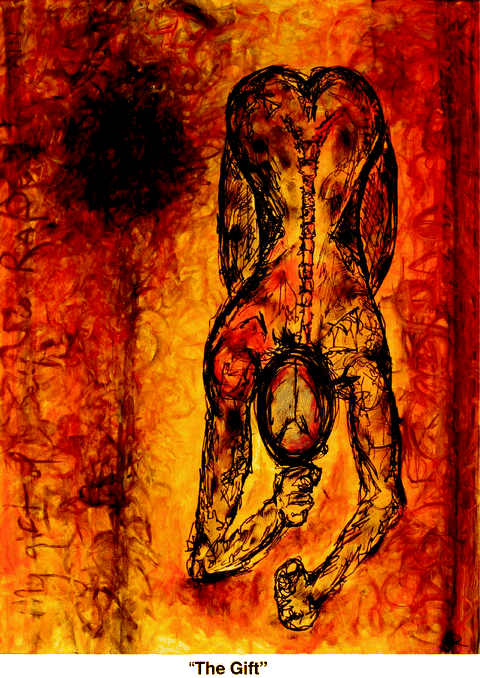

The Gift is one of my most raw and emotionally charged paintings. Its creation stems from emotions of a victim in chronic pain: physical agony, frustration, and the feeling that our health care system, with its aloof doctors and careless surgeons, has raped me of my gifts of life and my spirit. Shunned by the medical world and seen as a drug addict rather than a victim of physical pain, there is no help to heal or to find solace from the loneliness of chronic pain that engulfs me. I chose to hide the figure’s face from the viewer to play on the imagination of the viewer. There is no way to express the intensity and agony of chronic pain. It can only be experienced.
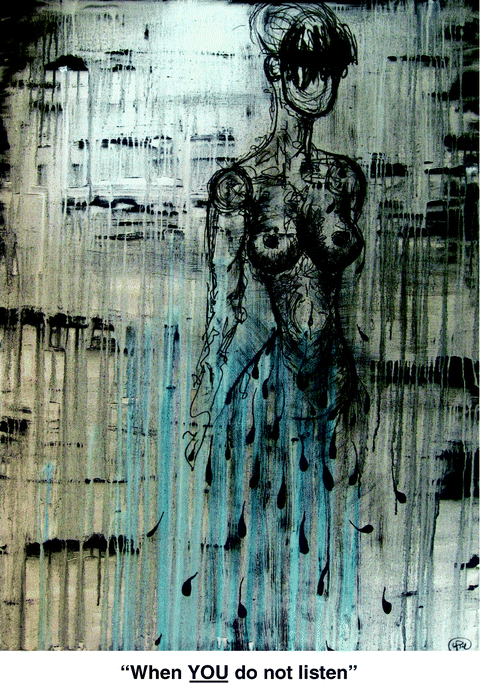

The title says it all. This is directed toward dr. d. I will not capitalize that name nor will I capitalize any dr.’s name unless they have fulfilled their oath as a provider. The oath a person takes when they get their diploma as a health care provider. This oath is a document that reflects that that person is responsible for our health in the utmost professional manner. We need to care, to provide, to help us direct our bodies in the best possible way without judgment. A Doctor is someone who will call you in person to check on you, to listen, to provide you with your life.
When You Do Not Listen is directed to you dr. d: you did not listen. That is how I felt. You are retired now. But to me, you failed your whole life as a Doctor.
At this stage of my search to find a solution to a pain cure I was convinced of my chance to live again free of pain was to get a pain pump implant. It looks like a tuna can, implanted into your lower abdomen and a catheter runs around your body into the intrathecal cavity. It is introduced into the space under the membrane which covers the brain and spinal cord of your spinal system. The thought is that the medication in the pump runs in the spinal space instead of your organs. I am a thin person so the tuna can stuck out like a knob. The medication had to be put in every month or few months depending on the rate of the medication dispersal. They take a six inch needle, thick, lay you on a table, and try to find the port in the pain pump with the hope that they find the port to stick the needle in, through the skin in the implant and when they hit the bottom you can feel it. Like a rock sinking into a glass tank, the noise it makes is felt. Not fun at all, and its very nerve racking. The pump was a torturous nightmare. Having it on my person was like having a dark cloud that followed me everywhere. I always worried about whether or not the catheter was going to slide out of my spinal cavity. With every movement I made, I would worry about the catheter.
One morning I woke up not feeling well and I felt my back, I could feel the coiled up catheter at the base of my back. Fear set in with a fierce rage. I had a major headache and I knew spinal fluid was leaking into my system causing my extremely painful spinal headache, by the time I got to the dr. d’s office I knew I needed surgery. The catheter had slipped out of the intrathecal cavity! The dr. came in, and I told him I had a spinal headache, the catheter was out, and I was with-drawing. He laughed. He literally laughed at me. I said, “I know my body and you need to listen.” He responded, “I will send you up stairs for an x-ray to make you feel better.” Then he walked out. Alone, I went upstairs, the stairs were spinning, the halls were long, and I was vomiting. The X-ray tech took the images and sent me back downstairs with a look of terror in his eyes. The tech said to go straight back to the dr. d’s, I need immediate attention. The look in the technician’s eye’s told me everything I already knew. As I approached the office, to my surprise my dr d. was rapidly sneaking away. And I say “sneaking” because his body was crunched in fear that I would spot him, I called his name, and he ran out. I know he heard me and I was stunned. I went in the office only to hear from receptionist say, “He is gone for the day.” Well, I demanded to speak to the RN, and she was the saving grace to this practice. She would be at the office first thing in morning. They were faxed my information to her. I knew that the catheter was out and stated to the manager of the office it is an atrocity that a dr. would run away not knowing what would happen to me, his patient, suffering withdrawing, with immense neck–back pain, and a severe spinal headache.
That evening the RN called me, she said, “sorry, Yvonne you are right, the catheter is completely out and come in first thing.” I couldn’t go to the ER, because they do not know a thing about implanted pumps and catheters. By the morning I knew I was close to convulsions and needed a ride. My friend drove me and her face told me more than I needed to know. We arrived at the office and the RN put me in the emergency bed that they had, and told me the surgery was scheduled for 1:30 pm. They got an IV of pain medication going to try to help my massive headache, pain and with-drawl symptoms. I went in and out of consciousness, the pain was fierce, and during this time dr. d came in and started a fight. Yes, a fight, with me and the RN. dr. d yelled at her saying he was not doing the surgery due to his vacation the next day. The RN told him that this kind of situation is why we have back up doctors on call. But instead, he said, “No,” and canceled my surgery. Yes, that is what he did. He bolted out of the room where I was shivering so hard, shivering as if I were naked in an Alaskan winter. I was vomiting, barely conscious, my head felt as if it was going to explode, my body ached like shards of glass were stabbing me repeatedly, and then he came back into my room and proceeded to talk to me as if I was fully functional and alert. I told him I wanted the nurse in the room with me and he said no. I said, yes, it is my right to have a witness. In response he dead bolted the doors so the nurse could not get in! The dr. said he would be back in a week to deal with me and wrote me eight prescriptions of narcotics. *Please Note: when you are beyond a point of catching up to a spinal headache, and in withdrawal, there is no way taking pills will even make a dent in your situation. So, with all my strength, I took him on. I told him he has failed his oath as a dr., and he had failed me from the start. Laughing at my proposal that the catheter was out from the beginning and running away just to go on vacation is spineless. I said the surgery was set and the on call Dr. could take over and that he was just was not doing his job. The dr. was so irate he yelled at me. He literally threw the prescriptions at me. They fell to the floor beside my bed. When he opened the door, the RN saw that I had fallen off the table, and was on the floor trying to collect what the dr. called “care on paper.” The RN tried to take the dr. on in the hallway. She said the same things I had, that it too was my right to have her as a witness in the office. The RN went to get the office manager and explain. Finally, she stepped up to the plate, went and got a wheel chair, QUIT her job, and took me about 30 yards to the ER. At this point with her it was ok to go to the ER, because she was educated about the pumps. She stayed with me, got me in immediately, and then called the on-call Dr. for the surgery. They quickly put medication in my new IV and knocked me out. I looked dead, felt dead, and I wanted this monstrous apparatus fixed. Thanks to a rare RN who took her oath seriously, my life was saved.
I now had a new Dr., a repaired catheter, and never heard from the other dr. again. He went on his vacation. I never filled the prescriptions. I stashed them away to use in an art project. From this experience, all I can say is, another surgery, another failed system, and a joke of a dr. that is world-famous for his innovation in pain pumps.
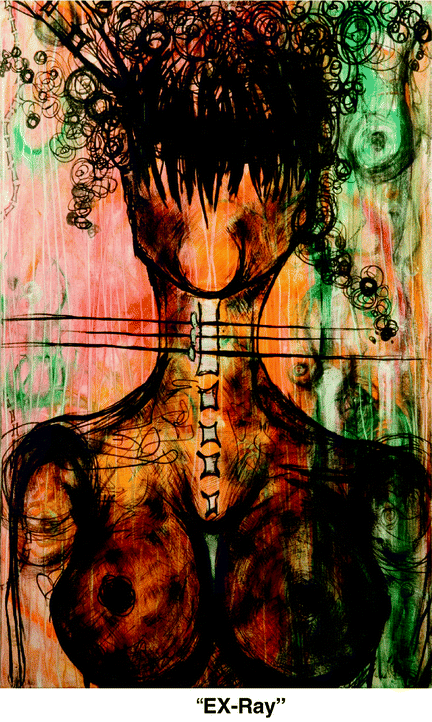

This painting titled Ex-Ray makes a simple yet overwhelming point about my experience with many doctors. Many times with doctors’ visits, the doctor would tend more to my physical beauty and sexuality than my overall health. This piece came from what an assisting doctor said while he thought, or perhaps “thought,” I was still under anesthesia. Tolerance against anesthesia builds with surgery, and he should have known that I was alert. Alert or not, what was spoken should never even be heard. This was surgery #8, and he said, “You would think after all these surgeries she would at least get implants by now.” Here I am waking up from major surgery and this idiot only thinks of me sexually. For the second time in my life, another doctor thinking my boobs just aren’t big enough! I have no words but a painting for the crazy-talk that came out of his mouth.
A lot of my drawings and paintings have the cheeks darkened in, and it wasn’t until a recent X-ray that I looked up in the light of the machine, and there before me was my face reflected perfectly divided with shadow lines and my cheeks darkened, like a super hero. All this time, and that subconscious creativity was working!
Why do I blacken out the eyes, and what is that black cover? A question asked frequently and only one person has figured it out. That was a great day for me in my studio/gallery; and it turns out he is in the health care system. He got it, and I thank this viewer, for understanding the depth of my art. Someday I will tell all, but for now, until I get my awareness out, I will let you try to figure it out.
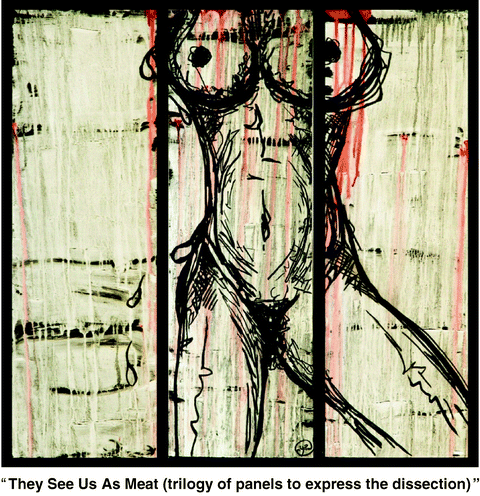

This piece titled They See US As Meat speaks for itself. This painting comes from the notion that after being a patient for so long, and coming to terms with the reality that most doctor’s use you, dissect your body, soul, and mind, and the medical world still continues to concentrate on the idealism of physical beauty in the bodies of women. Beauty is placed above health on a surgeon’s list of priorities. Each person regardless of gender should be seen as human and not separated into categories.
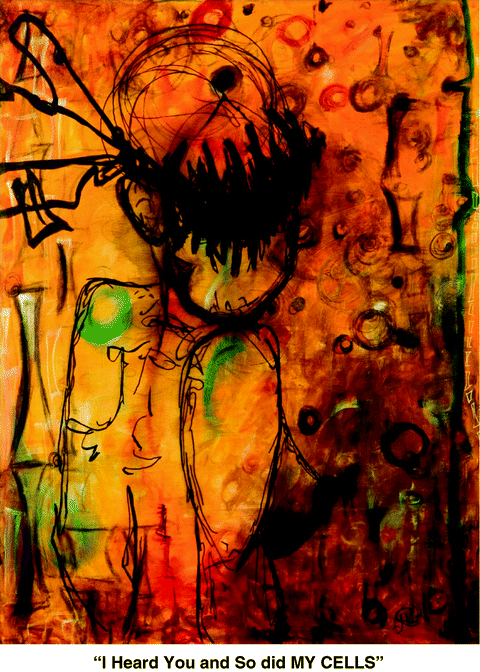

Simply put: every part of the human body hears you, feels you, and is affected down to the smallest atomic particle, the cell. Treat me with compassion, not with disgrace. All of me is watching, listening and feeling.
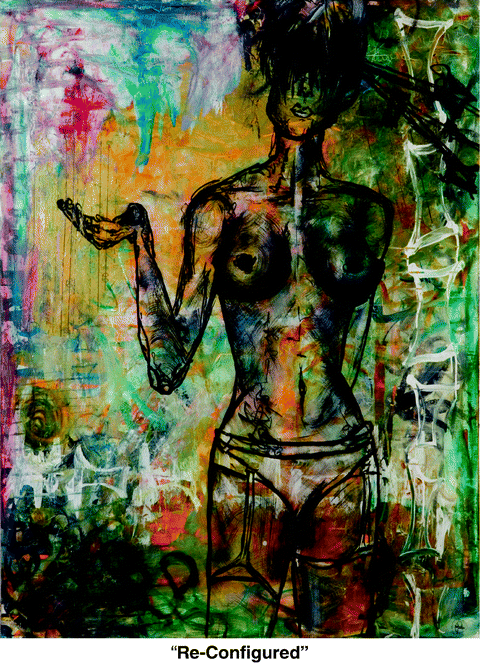

Re-Configured examines the irony between the fiber artist I was trained to be and many of the surgeons I have known. As a fiber artist, I created clothing by carefully cutting up fabric and sewing it together in a new configuration to create a functional garment or a thing of beauty. My garments emphasized precision and care for each pattern I worked with to create the best possible garment. In comparison, surgeons supposedly cut up people and put them back together again in the hope of making our bodies more useful to us. Yet, in my experience, many of the surgeons who have operated on me have been rude, aloof and careless during and after the surgery.
This painting also illustrates our medical culture’s emphasis on cosmetic beauty and money over health, supportive care, and helping each other. While I create fiber art in the name of self-expression, many of these doctors objectify bodies by seeing surgery as a moneymaker. It’s absurd to think I have put more care into my garments than many surgeons have put into my body.
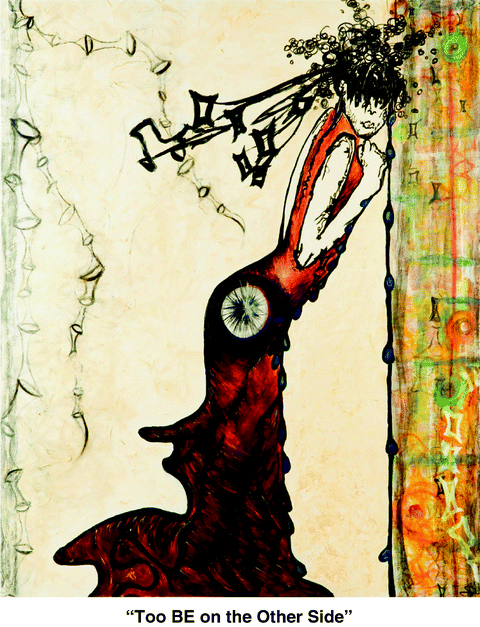

This painting titled Too BE on the Other Side represents the pain that is always haunting me. It expresses the want, the need, to be on the other side of life. On the other side there is color and life; where I exist, it is dark and wounding. I am constantly trying to hold on to myself as a woman, and as the tears of pain trickle down my cheeks, I hope only that God will put me back into the light.
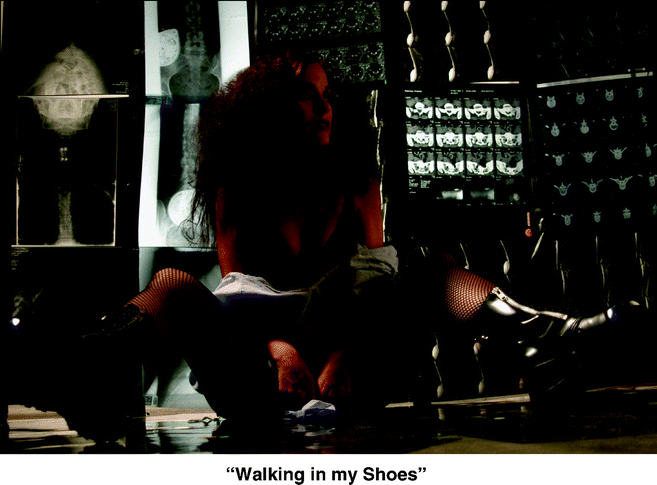

I currently have a passion for photography and ideas. I draw on and use my enormous amount of MRIs, CT scans, and other X-rays, and myself as a model to convey my experiences and communicate the irony of pain and health care, through the lens of a camera.
To create this photograph, titled Walking in my Shoes I created a wall of my MRIs, put on one of my hospital gowns from my DR. H (love you) and called my friend Theresa who captures the beauty in women through her lens. Theresa I thank you for your patience with my intensity and I love your willingness to understand what my mind was creating. I also appreciate you using me as your MUSE.
This photography symbolizes the beginning of many new ideas as I seed to portray the irony of beauty and pain. Many dr.’s have told me, “you are too pretty to have pain.” To which I always respond, “You cannot have pain with beauty?” Well, you can. Here I am. All people should be seen as humans needing help and guidance from the health care and never judged by their reasons for needing medical aid. Beauty and pain can co-exist because we are all beautiful.
Advocacy
As an artist I am utilizing my studio space to exhibit artwork that is derived from pain. My goal is awareness through my art, while my art saves me. I think our nation has gone too long without addressing that over 116 million people suffer daily with chronic pain, and this is every age group. One must remember: “WE ARE ALL JUST ONE ACCIDENT AWAY FROM CHRONIC PAIN.” This could be you tomorrow. There are so many of us that silently suffer. We have no colored ribbon to display that we exist and how much we suffer. If we did I would say it would be a black and grey ribbon. Pain to me can be defined within the color black, no matter how much light color you add, it will always be grey.
Where Medicine Needs to Go and What Changes Need to Take Place
If you are going to choose to work in the health care field, know this and you will go far with your career: follow through with your promise to honestly care for each and every person that you are gifted to meet. People are not numbers for a research test, not guinea pigs for money making industries, not here to make you fast cash, people coming to you are walking in with the trust that you care. Honestly care.
If You Cannot Care, Do Not Practice Medicine
I don’t know how many countless times I was handed a prescription of narcotics after just 5 min with no caring interaction but just physical motions that made me feel like a rock.
When you enter the room, look directly at the patient’s eyes and say hello with an introduction. No matter who is coming in the room; med tech, nurse, someone getting stocking supplies, and the doctor. Basic stuff right? But surprisingly this does not happen much and from my experience I usually would ask, “who are you?”
All health care workers need to listen and consult with new patients for at least 45 min before they start to medicate them. The goal during this time is to get to know your new patient, create a bond, and to figure out what category of patient has walked through your practice. To me, there seems to be three types of chronic pain patients: the drug addicts, the chronic pain authentic patient, or the chronic pain drug addict. So to spend time listening and getting a relationship will surely give you ample time to make a decision to base your care plan upon.
The drug addicts are there simply to get drugs. I would think within a smaller time frame and observation one can figure out what their motive for care is: To get high. This is where a chronic pain patient has received the stigma. So let’s understand there is a GREAT difference. If you have a patient seeking drugs, send them to rehab, refuse medication, talk to the family and figure out how to care for this person.
The authentic chronic pain patient, will have chart notes from their GP usually, tests done or needed, and will obviously show true pain. Although with drug addicts withdrawling one does have pain, there is a difference, after their withdrawal they are not living in physical pain, but with the mental and emotional challenges of their disease. So, with the chronic pain patient, take your time to listen. Truly listen, don’t jump into implantation devices, steroids and surgery. Ask the patient what they have been through, what they are taking, what have they taken, who they were before the pain and what they would like from you? The patient usually knows their body better than anyone. I know I do. Prescribe medication needed to lessen the suffering and hopefully make the patient’s life functional. Make sure flare up medication is dispensed as well. Since pain is so unpredictable on what causes flare ups, it is crucial to have those meds. Also understand that tolerance will happen. When you have been a long term patient like me, vicodin are like pez. This does NOT mean I am an addict. It means my body has biochemically adjusted. So work with that and make adjustments. Sometimes one must switch meds every few months just to keep the body from getting to use to the medication. Open communication is an imperative, and if you and your caregiver can discuss anything with no judgment but pure and compassionate care then the results will be much better. I know many patients out their afraid to discuss their medication tolerances due to the stigmas and this is just wrong. So as the health care provider, you bring it up! Break down that wall and create a safe place, to heal or deal with the pain. It is important that you discuss getting a lock box and a pad of paper to keep track of medication. In fact, hand it out with your prescriptions! Also jot down when you have a flare up and what you think ignited it so you can remember and you can tell your provider.

Full access? Get Clinical Tree





